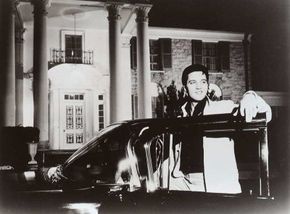Elvis Presley and the Press
Looking back, it all seems so harmless, but Elvis appeared on the scene at a time when rock 'n' roll was coming under fire in the popular press. The controversy centered on whether this new style of music associated with teenagers led to teenage sex and crime. During the spring and summer of 1956, many national magazines published articles that claimed there was a link between rock 'n' roll and juvenile delinquency.
At the same time, Elvis was often featured in these same magazines in articles that sensationalized the effect of his sensual performing style on teenage girls. Headlines blared "Presley's Impact Piles Up Fans, Fads -- and Fear," while trumped-up stories declared his "sex-hot flame" to be inextinguishable. It did not take a great leap of imagination for journalists, reviewers, and critics to relate Elvis' personal appearance and sensual performing style to the decadence of rock 'n' roll and the horrors of juvenile delinquency.
Advertisement
When the popular press was not openly criticizing Elvis, they were ridiculing him. Despite the fact that his music was identified as rock 'n' roll, journalists and reporters often referred to him disparagingly as a "hillbilly singer." He was maligned for his Southern accent, his flashy clothes, his long sideburns, and his ducktail haircut so heavily laden with pomade that his blond hair looked black.
The latter in particular seemed to raise the ire of the press and public alike. Never before had an entertainer's hair been the subject of so much attention; Elvis' hairstyle was criticized because of its length, its use of pomade, and the fact that so many teenagers emulated it.
Despite the predominance of negative stories about Elvis in the press, another type of publicity began to emerge slowly but surely. This new pattern of publicity presented a different Elvis Presley, a persona that was contradictory to the high-profile figure who had caused so much controversy. This gentler side of the singer's image has come to be known in Elvis lore and literature as the "other Elvis" or "good Elvis."
The "other Elvis" surfaced on July 1, 1956, on the television interview program Hy Gardner Calling. The program consisted of syndicated columnist Gardner calling one or two celebrities on the telephone each week. A split-screen technique allowed viewers to watch both Gardner and the celebrity as they talked on the phone.
The episode featuring Elvis gave the young singer an opportunity to dispel some of the vicious rumors that were circulating about him, including one that purported he often smoked marijuana to reach the frenetic state necessary for his performing style and another that stated he had once shot his mother. Viewers saw a down-to-earth Elvis, who expressed that he was experiencing confusion over the enormity of his success. He also professed disbelief that critics could find his music to be a negative influence on anyone.
Stories about Elvis' close relationship with his parents began to appear in print. The fact that he didn't smoke or drink was brought out in some articles. Elvis was known to be polite during interviews, referring to his elders as "sir" or "ma'am." Colonel Parker publicized Elvis' strong feelings about helping less-fortunate people and booked him for many charity benefits, including those for the American Cancer Society and the March of Dimes.
Still, publications touted singer Pat Boone as a more clean-cut -- therefore a more appropriate -- teenage idol than Elvis Presley. Parker then tried to make Elvis seem more wholesome by getting his name and picture on a line of children's products. The Colonel sealed a deal with promoter extraordinaire Hank Saperstein to merchandise Elvis along the same lines as his other famous clients, who included Wyatt Earp, the Lone Ranger, and Lassie. Every child in the country could find these all-American heroes on everything from lunch boxes to T-shirts.
The Colonel wanted them to find Elvis' image on such products as well. In addition to the usual line of children's items, girls were able to buy Elvis Presley lipstick in colors of Hound Dog Orange, Tutti Frutti Red, and Heartbreak Pink. They could also get Elvis Presley charm bracelets to wear. Parker exploited this "other Elvis" image to counter the portrayal of Elvis as a hedonistic rock 'n' roller and push the singing idol closer toward respectability.
Reporters of the mainstream press had saddled Elvis with what they thought was a clever nickname, "Elvis the Pelvis" -- a name the serious young singer despised. On Hy Gardner's television interview program, Elvis complained, "I don't like being called Elvis the Pelvis -- I mean it's one of the most childish expressions I have ever heard coming from an adult." By referring to his gyrating hips, the moniker became shorthand for the accusations of tastelessness that dogged Elvis during this time. The Colonel hoped to erase "Elvis the Pelvis" from the public consciousness by showcasing the "other Elvis" at every turn.
Another step in Elvis' transformation occurred with his career move into Hollywood movies. During the years 1956 to 1958, four films featuring Elvis Presley were released to enthusiastic audiences. The films recast Elvis the Pelvis into Elvis the Rebel, a subtle but significant change. As Hollywood's newest rebel, Elvis eased into a more recognizable persona, already made acceptable by Marlon Brando and James Dean.
Love Me Tender was Elvis' first foray into acting, and all eyes were peeled to see how the young singer would perform. See the next section to learn more about Elvis' role in Love Me Tender.
